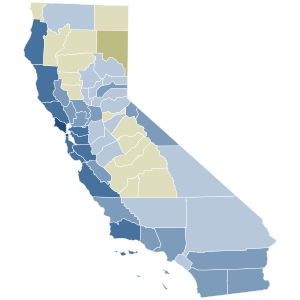| Criminal Sentences & Juvenile Crime Proceedings | ||||||||||||||||||||||
| Results | ||||||||||||||||||||||
|---|---|---|---|---|---|---|---|---|---|---|---|---|---|---|---|---|---|---|---|---|---|---|
| ||||||||||||||||||||||
 Results by county Results by county
| ||||||||||||||||||||||
| Source: California Secretary of State | ||||||||||||||||||||||
Proposition 57 was an initiated California ballot proposition, approved on the November 8, 2016 ballot. The Proposition allows parole consideration for nonviolent felons, changes policies on juvenile prosecution, and authorizes sentence credits for rehabilitation, good behavior, and education.
The proposition
Due to the approval of the proposition, the California Department of Corrections and Rehabilitation will begin to implement these new parole and sentencing provisions. The passage and implementation of the proposition may allow the state to save tens of millions of dollars each year.
Proposition 57 allows the parole board to release nonviolent prisoners once they have served the full sentence for their primary criminal offense. Previously, prisoners were often required to serve extra time by a sentence enhancement, such as those for repeated offenders. In addition, Proposition 57 requires the Department of Corrections to develop uniform parole credits, which reward prisoners' good behavior with reduced sentences.
This proposition allows juvenile court judges to determine whether or not juveniles aged fourteen and older should be prosecuted and sentenced as an adult, repealing California Proposition 21, which was passed in March 2000. Proposition 21 gave prosecutors the sole authority to decide whether to try a young offender as a juvenile or adult.
Proposition 57's proponents sought to restore juvenile court judges’ authority over juvenile offenders. The California Department of Corrections and Rehabilitation has been under federal court supervision since the Supreme Court of the United States found that California's prison overcrowding constitutes cruel and unusual punishment (Brown v. Plata, 2011).
Proponents
Proponents of the measure spent $11.75 million. The top contribution was $4.14 million raised by Governor Brown. Other proponents responsible for significant contributions included the California Democratic Party, Tom Steyer, Reed Hastings, and the Open Philanthropy Project. The measure was also supported by the editorial boards of the Los Angeles Times, the San Francisco Chronicle, and The Sacramento Bee.
Opponents
Opponents of the Proposition argued that it would release potentially dangerous criminals due to improper classification of crimes as non-violent including domestic violence and child molestation.
Opponents of the Proposition spent $641,326 fighting against the measure. Opponents that made high contributions included Los Angeles County police unions and a prosecutor lobbying group.
Result
Proposition 57 was approved by voters in the November General Election, with 64.46% voting in favor.
References
- "Statement of Vote - November 8, 2016, General Election". December 16, 2016. Retrieved January 7, 2017.
- "Proposition 57. California General Election November 8, 2016. Official Voter Information Guide". California Secretary of State. Archived from the original on 11 October 2016. Retrieved 10 October 2016.
- "Prop 57 Analysis | Official Voter Information Guide | California Secretary of State". voterguide.sos.ca.gov. Archived from the original on 2016-10-12. Retrieved 2016-10-11.
- ^ Lagos, Marisa. "Election 2016: Proposition 57". KQED News. Archived from the original on 28 October 2016. Retrieved 28 October 2016.
- ^ Lantigua-Williams, Juleyka (9 September 2016). "Treating Young Offenders Like Adults Is Bad Parenting". The Atlantic. Retrieved 28 October 2016.
- The Editorial Board of the Los Angeles Times (5 October 2016). "Prop 57 is a much-needed check on prosecutorial power. Vote yes". The Los Angeles Times. Retrieved 28 October 2016.
- The Editorial Board of the San Francisco Chronicle (11 September 2016). "The Chronicle recommends: Yes on Prop. 57". The San Francisco Chronicle. Retrieved 28 October 2016.
- The Editorial Board of the Sacramento Bee (27 September 2016). "Prop. 57 would fix a mistake, help rehabilitate felons". The Sacramento Bee. Retrieved 28 October 2016.
- Stickney, B. "Guide to Proposition 57: Parole for Non-Violent Criminals". NBC San Diego. NBC 7 San Diego. Retrieved 9 January 2017.
- "California Proposition 57, Parole for Non-Violent Criminals and Juvenile Court Trial Requirements (2016)". Ballotpedia. Retrieved 18 January 2017.
